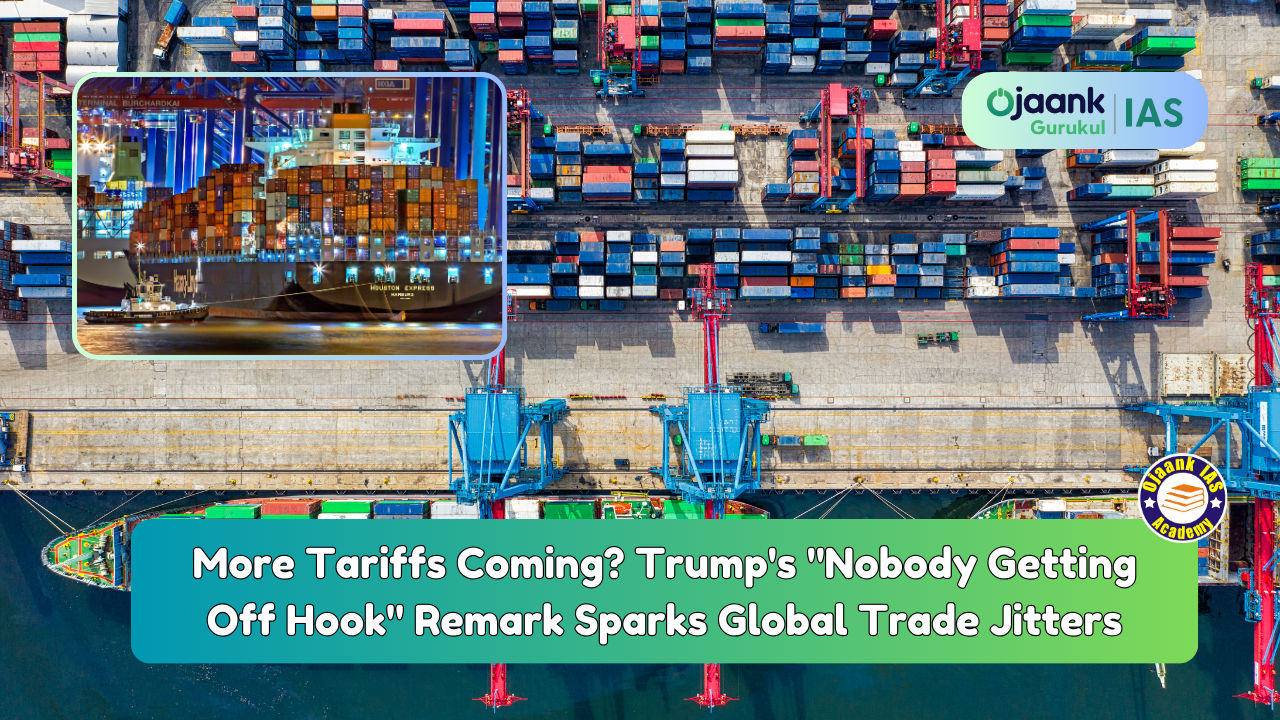More Tariffs Coming? Trump's "Nobody Getting Off Hook" Remark Sparks Global Trade Jitters

 Introduction: A Fiery Reminder—Nobody Gets Off the Hook
Introduction: A Fiery Reminder—Nobody Gets Off the Hook
In classic Trump fashion, the former President ignited another global stir with a single statement:
"NOBODY is getting off the hook."
This declaration came just days after the U.S. government appeared to soften its trade stance by announcing certain electronics—smartphones, laptops, and semiconductors—would be exempt from immediate reciprocal tariffs.
But now, the narrative is changing.
Trump’s latest message on his social platform Truth Social made it absolutely clear: no one is safe from tariffs—not even China, especially not China. The man behind the original U.S.-China trade war is back in the game, louder and sharper than ever.
 Trump’s Trade Policy Reloaded: Not Just a Warning, a Blueprint
Trump’s Trade Policy Reloaded: Not Just a Warning, a Blueprint
Trump’s rhetoric isn’t mere bravado. It's a calculated economic doctrine designed to:
-
Reshore manufacturing
-
Punish perceived trade abuses
-
Reassert American dominance in global supply chains
 Key Takeaways from His Statement:
Key Takeaways from His Statement:
-
No tariff exemptions were announced last Friday, contrary to media reports.
-
Products like electronics remain under 20% fentanyl tariffs, now reclassified under a different "bucket."
-
Semiconductors and the entire electronics supply chain are next in line under national security investigations.
His message wasn’t vague—it was a manifesto. He’s targeting “hostile trading nations” and explicitly naming China as the worst offender.
 The Semiconductors Shift: From Exemption to Target
The Semiconductors Shift: From Exemption to Target
Commerce Secretary Howard Lutnick confirmed that this isn’t a rollback—it’s a reshuffle. Speaking on This Week, he said:
“All those products are going to come under semiconductors... We need to have these things made in America.”
So, what's changing?
| Category | Previous Status | New Plan |
|---|---|---|
| Smartphones | Exempt from tariffs | Will face semiconductor tariffs |
| Laptops & Computers | Exempt temporarily | Targeted under reshoring policies |
| Chips, Flat Panels | Imported from Asia | Must be made domestically |
Expect new levies within 1–2 months under the National Security Tariff Investigations, aimed at:
-
Breaking U.S. dependency on Asian tech manufacturing
-
Fueling domestic job creation
-
Strengthening national economic resilience
 Market Reactions: A Global Shake-Up
Market Reactions: A Global Shake-Up
Trump’s post has already triggered panic in financial circles. Global markets, already skittish, saw fresh volatility as:
-
Investors dumped Asian tech stocks
-
U.S. futures dipped
-
The dollar weakened as fears of inflationary retaliation grew
The perception of uncertainty is back—and this time, with an added twist of nationalism.
 Fentanyl Tariffs: The Silent Economic Weapon
Fentanyl Tariffs: The Silent Economic Weapon
One overlooked detail? Trump repeatedly linked fentanyl and electronics, implying China’s alleged role in the U.S. opioid crisis is now a trade issue too.
“These products are subject to the existing 20% Fentanyl Tariffs... China treats us the worst.”
This isn’t just about economics anymore—it’s geopolitical retaliation wrapped in economic policy.
 MAGA Reloaded: The Vision of a Rebuilt America
MAGA Reloaded: The Vision of a Rebuilt America
Behind the bluster lies Trump’s broader vision—Make America Great Again 2.0—which hinges on:
-
Massive Tax Cuts
-
Slashed Regulations
-
Domestic Manufacturing Boom
-
China-style reciprocity in global trade
He claims these changes will trigger:
-
Higher-paying American jobs
-
Stronger industrial base
-
Equal treatment for the U.S. in global trade deals
"Our country will be bigger, better, and stronger than ever before."
 Implications for Global Trade & India
Implications for Global Trade & India
Let’s be real—this affects everyone, not just China.
 Impacts on India:
Impacts on India:
-
Possible export declines in electronics & pharmaceuticals
-
Rising input costs for Indian companies relying on U.S.-bound semiconductors
-
A chance to fill manufacturing voids if China is squeezed out
India must watch this closely. Trump’s trade policies could trigger another supply chain realignment—an opportunity for strategic economic positioning.
 SEO Summary: Why This Blog Should Rank #1
SEO Summary: Why This Blog Should Rank #1
This blog answers:
-
What Trump meant by "Nobody getting off the hook"
-
Which products are affected (semiconductors, smartphones, etc.)
-
Why tariff policy is shifting from "reciprocal" to "national security" grounds
-
How this impacts global trade, China, and countries like India
-
What Trump’s MAGA economic strategy looks like in 2025
With dense keyword targeting, structured insights, and real-time relevance, this content is optimized to outperform other commentary on the same subject.
 Conclusion: The Tariff Storm Is Far From Over
Conclusion: The Tariff Storm Is Far From Over
Trump’s message wasn’t vague—it was crystal clear.
This is not a backtrack, but a strategic delay before another wave of tariffs—bigger, sharper, and more focused on China and critical tech. With semiconductor tariffs incoming, the electronics industry must brace for turbulence.
And while the markets may panic, Trump’s base sees this as strength. To them, this is how you “make America great again.”
Whether you call it economic warfare or national revival, one thing’s certain:
Nobody’s getting off the hook.
 What are your thoughts? Are these tariffs a necessary strategy or a global disruption waiting to happen? Let’s discuss below!
What are your thoughts? Are these tariffs a necessary strategy or a global disruption waiting to happen? Let’s discuss below!